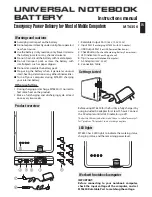
Switches
A switch completes or breaks the path of a current or sends
it over a different p a t h . Its operation is digital because its
o u t p u t is " 1 " or " 0 " , or " h i g h " or " l o w " . There are two
types in switches, conventional metal-contact switch a n d
contact-pointless switch or electronic switch m a d e of a
transistor or an I C . The electronic switch is omitted here.
b) Slide Type
A conductive piece slides and engages with the other piece.
This has a self-cleaning ability. It scrubs off by itself the
resistive film of dust and sulfite formed on its contact sur
face. This is suitable for dealing with small current and
not for switching in high frequency. Fig. 2 shows the prin
ciple of slide contacts.
1 . C o n t a c t s
Contacts are the heart of a switch where an electric circuit
is opened or closed.
Movable contact Fixed contact
Open
Closed
1.1 Material
Contacts are made of silver (Ag) and its alloy, copper (Cu)
a n d its alloy, gold (Au) and its alloy or other highly con
ductive materials to m a k e the resistance at a contact point
lower than 100m 12. The materials have both merits and de
merits. They should be used in the right place.
1 . 2 STRUCTURE
There are two types of switches; push type and slide type.
a) Push Type
In this type contact is m a d e by pressing a conductive piece
against the other. This is suitable for frequent on-off oper
ation of a large current at a high speed. Fig. 1 shows the
principle of push contacts.
Fig. 1 Principle of Push Contacts
2
Fig. 2 Principle of Slide Contacts
1.3 Symbols
There are several kinds of switch symbols as shown in
Table 1. The symbols effectively show the mechanism of
switches a n d features of circuits.
Contacts
Symbols
Push type
Slide type
Table 1 Various Switch Symbols
Fixed contact
Movable contact





































